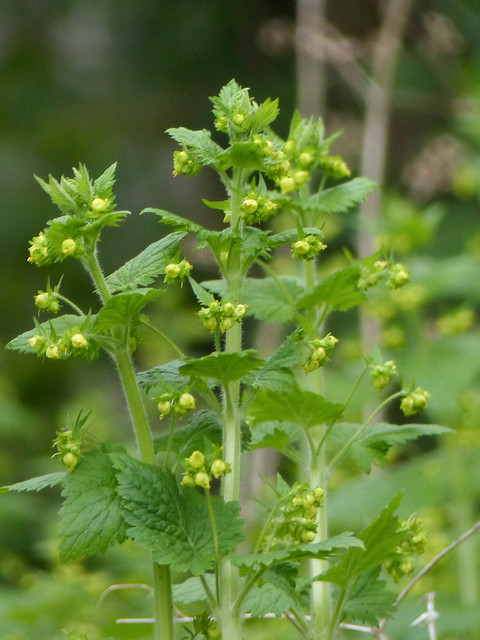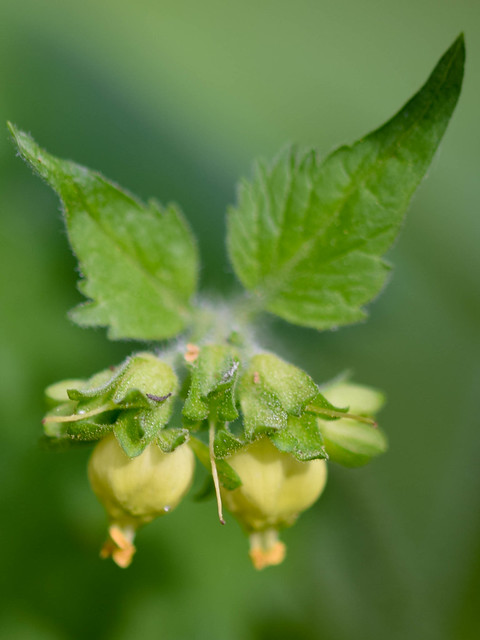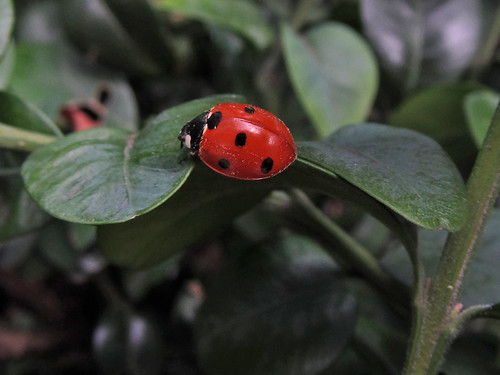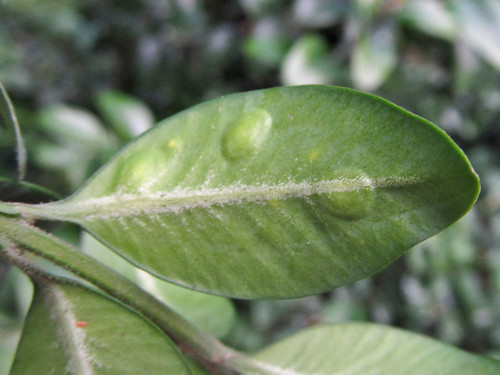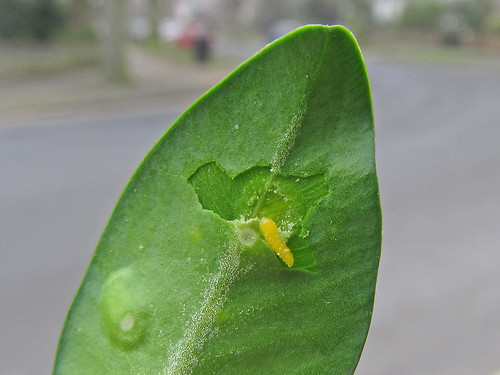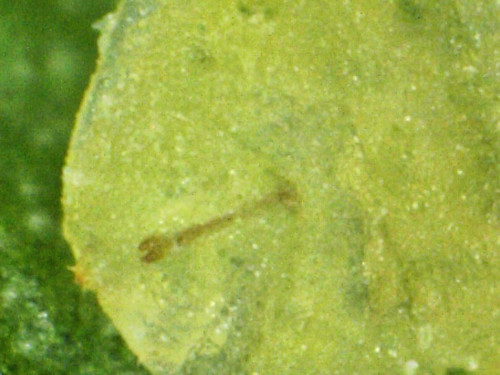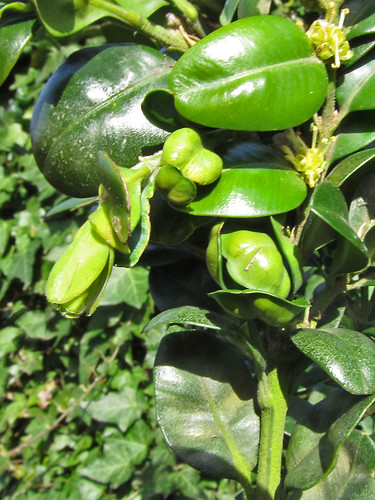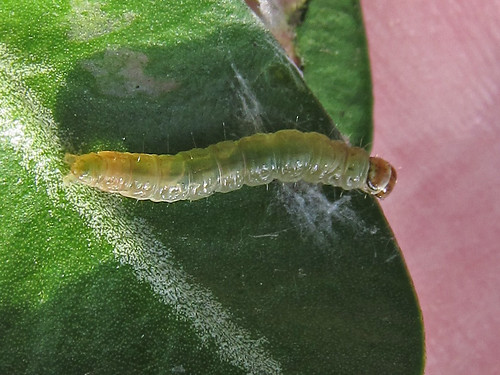Class Arachnida [Arthropoda]
Acarina – mites (3)
Class Insecta [Arthropoda]
Hemiptera – true bugs (21)
Common flower bug Anthocoris nemorum
(Linnaeus) [Cimicidae]. 197. A general predator of red-spider mites, greenflies and other insects
and is found on many deciduous trees - e.g. apple, oak, hawthorn -and
also on herbage, especially nettles. .4 1
bug
Xylocoridea
brevipennis Reuter
[Cimicidae]. 212. Lives under the bark of apple and hawthorn trees throughout
the year.5 2
? Psallus ambigus (Fallén)
[Miridae]. 257. This species is widely distributed
throughout the British Isles on apple, hawthorn, sallow and alder
trees. .6 3
bug
Atractotomus
mali (Meyer-Dür)
[Miridae]. 275. It is partly predacious, but
hawthorn and apple are its chief host-plants and the adults are found
on these from late June until early August. 4
Lepidoptera – butterflies & Moths(53)
micromoth Ectoedemia atricollis (Stainton
1857) [Nepticulidae]. 29. Larvae monophagous on leaves.
Significant Impact.25 1
micromoth Stigmella oxyacanthella (Stainton
1854) [Nepticulidae]. 100. leaves,oligophagous,-,-, .28 4
micromoth Stigmella perpygmaeella (Doubleday
1859) [Nepticulidae]. 79. leaves,monophagous,-,I, .30 6
Pear Leaf Blister Moth Leucoptera malifoliella
(Costa 1836) [Lyonetiidae]. 260. leaves,oligophagous,-,I, .33 9
micromoth Bucculatrix bechsteinelle
(Bechstein & Scharfenberg 1805) [Lyonetiidae]. 275.
,leaves,oligophagous,-,-, .35 11
micromoth Phyllonorycter oxyacanthae (Frey
1856) [Gracillariidae]. 323. ,leaves,monophagous,-,I, .37 13
micromoth Phyllonorycter corylifoliella
(Hübner 1796) [Gracillariidae]. 332. leaves,polyphagous,-,I,
.38 14
Apple Leaf Skeletonizer Choreutis pariana
(Clerck 1759) [Choreutidae]. 389. leaves,oligophagous,-,-, .39 15
micromoth Argyresthia semifusca
(Haworth 1828) [Yponomeutidae]. 419.
shoots,oligophagous,-,-, .40 16
micromoth Argyresthia bonnetella (L. 1758)
[Yponomeutidae]. 421. buds, flower buds, &
leaves,monophagous,-,I,.41 17
Orchard Ermine Yponomeuta padella (L. 1758)
[Yponomeutidae]. 425. leaves,oligophagous,-,I, .Wingspan 19-22
mm. The larvae feed on blackthorn (Prunus spinosa), hawthorn
(Crataegus) and cherry (Prunus spp), and like its relatives lives
gregariously in a silken web. 42 18
micromoth Paraswammerdamia lutarea (Haworth
1828) [Yponomeutidae]. 441. stems & leaves,oligophagous,-,I,
.44 20
Hawthorn Moth Scythropia crataegella
(Fabricius 1775) [Yponomeutidae]. 450. leaves,oligophagous,-,I,
.45 21
micromoth Coleophora coracipennella (Hübner
1796) [Coleophoridae]. 494. ,leaves,oligophagous,subsidiary,-,
.48 24
Apple and Plum Case-bearer Coleophora spinella
Packard 1870 [Coleophoridae]. 493. buds,leaves,oligophagous,-,I,
.50 26
micromoth Coleophora trigeminella Fuchs 1881
[Coleophoridae]. 502. buds,leaves,oligophagous,-,-, .51 27
micromoth Semioscopis steinkellneriana ([D&S]
1775) [Oecophoridae]. 667. Oligophagous on leaves with C. a
subsidiary FP.52 28
micromoth Teleiodes vulgella ([D&S] 1775)
[Gelechiidae]. 765. leaves,polyphagous,principal,-, .54 30
micromoth Spuleria flavicaput (Haworth
1828) [Cosmopterisidae]. 904. woody
parts,monophagous,-,-, .56 32
micromoth Blastodacna hellerella (Duponchel
1838) [Cosmopterisidae]. 905. fruits/seeds,monophagous,-,-, .57 33
Garden Rose Tortrix Acleris variegana ([D&S]
1775) [Tortricidae]. 1048. leaves,oligophagous,-,-, .60 36
tortrix moth Acleris cristana ([D&S]
1775) [Tortricidae]. 1054. Larvae oligophagous on leaves with C.
a subsidiary FP.62 38
tortrix moth Ancylis achatana ([D&S]
1775) [Tortricidae]. 1115. leaves,oligophagous,principal,-, .63 39
tortrix moth Epiblema trimaculana (Haworth
1811) [Tortricidae]. 1176. leaves,monophagous,-,-, .64 40
tortrix moth Hedya dimidioalba Author Date [Tortricidae].
,flowers,leaves,shoots,oligophagous,principal,-, .65 41
tortrix moth Neosphaleroptera nubilana Author Date
[Tortricidae]. ,leaves,oligophagous,principal,-, .66 42
tortrix moth Pammene spiniana (Duponchel
1843) [Tortricidae]. 1231. flowers,oligophagous,subsidiary,-,
.68 44
micromoth Trachycera advenella (Zincken 1818)
[Pyralidae]. 1439. flowers,leaves,oligophagous,principal,-, .70 46
December Moth Poecilocampa populi (L. 1758)
[Lasiocampidae]. 1631. Larva. April to June on a variety of
deciduous trees, including oak, birch, elm, hawthorn, poplar and
lime. Overwinters as an egg.72 48
Pale Eggar Trichiura crataegi (L. 1758)
[Lasiocampidae]. 1632. Larva. April to June mainly on blackthorn, hawthorn and birch,
but also found on sallow, oak, bramble, bilberry and heather.73 49
Small Eggar Eriogaster lanestris (L.
1758)[Lasiocampidae]. 1633. leaves,oligophagous,subsidiary,-, . Larva. April to early July mainly on blackthorn, hawthorn
and occasionally wild rose, 74 50
Mottled Pug Eupithecia exiguata (Hüb.
1809-1813(?)) [Geometridae]. 1819. ,-,oligophagous,principal,-,
.75 51
Pinion-spotted Pug Eupithecia insigniata
(Hüb. 1790) [Geometridae]. 1820.
leaves,oligophagous,principal,-, .76 52
Oak-tree Pug Eupithecia dodoneata Guenée
1857 [Geometridae]. 1853. ,-,oligophagous,principal,-, .77 53
Diptera – true flies (3)
Hymenoptera – ants, bees & wasps (0)
Coleoptera – beetles (7)
leaf-roller Involvulus caeruleus (De Geer
1775) [Rhynchitidae]. Oligophagous on leaves with C. the
principal FP.83 1
leaf-roller Neocoenorrhinus aequatus (L.
1767) [Rhynchitidae]. Oligophagous on fruits/seeds with C. the
principal FP..84 2
leaf-roller Neocoenorrhinus pauxillus (Germar
1824) [Rhynchitidae]. Oligophagous on leaves with C. the
principal FP.85 3
weevil Anthonomus chevrolati Desbrochers 1868
[Curculionidae]. Monophagous on buds with C. the principal FP.86 4
weevil Anthonomus pedicularius (L. 1758)
[Curculionidae]. Monophagous on flowers with C. the principal
FP.87 5
weevil Magdalis ruficornis (L. 1758)
[Curculionidae]. Oligophagous on woody parts with C. a subsidiary
FP.88 6
weevil Ramphus oxyacanthae (Marsham, 1802)
[Curculionidae]. Oligophagous on leaves with C. the principal
FP..89 7
1Redfern,
Shirley & Bloxham (2011: 91).
2Redfern,
Shirley & Bloxham (2011: 91).
3Redfern,
Shirley & Bloxham (2011: 92).
4Southwood
& Leston (1958: 178-179).
5Southwood
& Leston (1958: 187).
6Southwood
& Leston (1958: 223-224).
7Southwood
& Leston (1958: 228).
8EFBI
(2005).
9EFBI
(2005).
10EFBI
(2005).
11EFBI
(2005).
12EFBI
(2005).
13EFBI
(2005).
14EFBI
(2005).
15EFBI
(2005); Dixon & Thieme (2007: 65 & 93).
16EFBI
(2005); Dixon & Thieme (2007: 64 & 93).
17EFBI
(2005); Dixon & Thieme (2007: 65 & 94).
18EFBI
(2005); Dixon & Thieme (2007: 65 & 94).
19Redfern,
Shirley & Bloxham (2011: 90).
20EFBI
(2005); Dixon & Thieme (2007: 65 & 103).
21EFBI
(2005); Dixon & Thieme (2007: 65 & 103).
22Dixon
& Thieme (2007: 64 & 111).
23EFBI
(2005); Dixon & Thieme (2007: 65 & 114).
24EFBI
(2005).
25EFBI
(2005).
26EFBI
(2005).
27EFBI
(2005).
28EFBI
(2005).
29EFBI
(2005).
30EFBI
(2005).
31EFBI
(2005).
32EFBI
(2005).
33EFBI
(2005).
34EFBI
(2005).
35EFBI
(2005), family as Bucculatricidae.
36EFBI
(2005).
37EFBI
(2005).
38EFBI
(2005).
39EFBI
(2005).
40EFBI
(2005).
41EFBI
(2005).
42EFBI
(2005); Kimber (2006).
43EFBI
(2005).
44EFBI
(2005).
45EFBI
(2005).
46EFBI
(2005).
47EFBI
(2005).
48EFBI
(2005).
49EFBI
(2005).
50EFBI
(2005).
51EFBI
(2005).
52EFBI
(2005).
53EFBI
(2005).
54EFBI
(2005).
55EFBI
(2005), genus as Teleiodes.
56EFBI
(2005).
57EFBI
(2005).
58EFBI
(2005), genus as Croesia.
59EFBI
(2005).
60EFBI
(2005).
61EFBI
(2005).
62EFBI
(2005).
63EFBI
(2005).
64EFBI
(2005).
65EFBI
(2005).
66EFBI
(2005).
67EFBI
(2005).
68EFBI
(2005).
69EFBI
(2005).
70EFBI
(2005), genus as Numonia.
71EFBI
(2005).
72Skinner
(2003).
73Skinner
(2003)..
74EFBI
(2005).
75EFBI
(2005).
76EFBI
(2005).
77EFBI
(2005).
78EFBI
(2005), genus as Thera (misspelt).
79EFBI
(2005).
80Redfern,
Shirley & Bloxham (2011: 93).
81Redfern,
Shirley & Bloxham (2011: 90).
82Redfern,
Shirley & Bloxham (2011: 93).
83EFBI
(2005), genus as Rhynchites, family as Attelabidae.
84EFBI
(2005), genus as Rhynchites, family as Attelabidae.
85EFBI
(2005), genus as Rhynchites, family as Attelabidae.
86EFBI
(2005); Redfern, Shirley & Bloxham (2011: 90) as A.
bituberculatus.
87EFBI
(2005); Redfern, Shirley & Bloxham (2011: 92).
88EFBI
(2005).
89EFBI
(2005).

